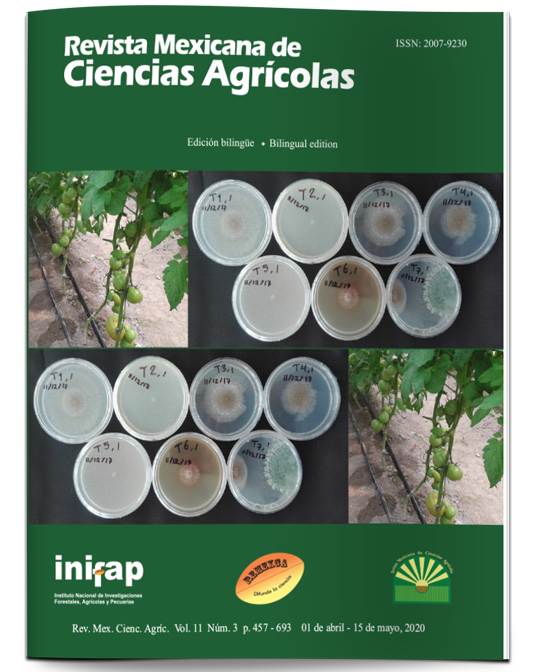Losses caused by Zymoseptoria tritici in wheat genotypes in storm environments
DOI:
https://doi.org/10.29312/remexca.v11i3.1788Keywords:
Triticum aestivum, Zymoseptoria tritici, leaf blight, susceptible varieties, yieldAbstract
Leaf blight caused by Mycosphaerella graminicola (anamorph Zymoseptoria tritici or Septoria tritici), is a disease present in rainy areas of seasonal wheat crops in the High Valleys of Central Mexico. The effect on grain yield caused by the disease is variable, depending on the locality and the resistance level of the varieties. The objectives of the research were to determine the percentage of losses caused by leaf blight and the response of commercial varieties planted in storm environments. Five varieties of bread wheat were evaluated in two treatments, with and without control of the disease, in the towns of Juchitepec, State of Mexico and Nanacamilpa, Tlaxcala, during the summer 2007 and 2008 cycles. The experimental design was complete random blocks with four repetitions under split plot treatment arrangement. The decrease in yield caused by leaf blight was 41 and 40% in Salamanca S75 and Gálvez M87 respectively, 33% for Verano S91, Triunfo F2004 24% and 9% losses in Rebeca F2000. Based on their resistance level, three groups of varieties were determined: Rebeca F2000 as resistant, Triunfo F2004 moderately resistant, Gálvez M87, Salamanca S75 and Verano S91 susceptible. The best test site was Juchitepec, Estate from Mexico. These results indicate that greater resistance to Zymoseptoria should be incorporated in future varieties, including Rebeca F2000 as a source of resistance, which will reduce losses in farmers yield in environments where the disease is important.
Downloads
Published
How to Cite
Issue
Section
License
The authors who publish in Revista Mexicana de Ciencias Agrícolas accept the following conditions:
In accordance with copyright laws, Revista Mexicana de Ciencias Agrícolas recognizes and respects the authors’ moral right and ownership of property rights which will be transferred to the journal for dissemination in open access. Invariably, all the authors have to sign a letter of transfer of property rights and of originality of the article to Instituto Nacional de Investigaciones Forestales, Agrícolas y Pecuarias (INIFAP) [National Institute of Forestry, Agricultural and Livestock Research]. The author(s) must pay a fee for the reception of articles before proceeding to editorial review.
All the texts published by Revista Mexicana de Ciencias Agrícolas —with no exception— are distributed under a Creative Commons License Attribution-NonCommercial 4.0 International (CC BY-NC 4.0), which allows third parties to use the publication as long as the work’s authorship and its first publication in this journal are mentioned.
The author(s) can enter into independent and additional contractual agreements for the nonexclusive distribution of the version of the article published in Revista Mexicana de Ciencias Agrícolas (for example include it into an institutional repository or publish it in a book) as long as it is clearly and explicitly indicated that the work was published for the first time in Revista Mexicana de Ciencias Agrícolas.
For all the above, the authors shall send the Letter-transfer of Property Rights for the first publication duly filled in and signed by the author(s). This form must be sent as a PDF file to: revista_atm@yahoo.com.mx; cienciasagricola@inifap.gob.mx; remexca2017@gmail.
This work is licensed under a Creative Commons Attribution-Noncommercial 4.0 International license.



